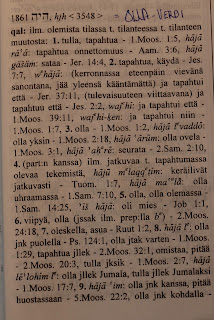Okkultistinen ajattelumalli kuusta ja auringosta on tarttunut jopa kuningas Jaakon käännökseen Jes. 13: 10:ssa. Okkultismissa kaikki mahdollinen nähdään seksin kautta jopa taivaankappaleet; kuu (puolikuu!) on feminiinen ja aurinko maskuliininen.
There is an occultic contamination in Isa 13: 10 in the King James Version. In Occultism everything is seen through sex even the heavenly bodies; the moon (half moon!) is female and the sun male.
Sama teksti toisen englantilaisen käännöksen mukaan; HNV = Hebrew Names Version of the World English Bible.
The same text in HNV = Hebrew Names Version of the World English Bible.
Maikku, joka opettaa minulle hepreaa, huomasi kaiken lisäksi, että sanojen "aurinko" ja "kuu" suvut ovat heprean kielessä juuri päinvastoin. Samoin ne ovat myös saksan kielessä. Tämän johdosta ihmettelen ja kysyn vain, mikä okkultistien joukko on mahtanut olla väsäämässä kuningas Jaakon käännöstä?!
By the way Maikku who teaches me Hebrew noticed that the genders of the words "sun" and "moon" are just opposite in Hebrew. The same thing is also in German. Therefore I must wonder and ask what kind of occultic group have been creating the King James Version?!
Minäkin "pöllö" olen tähän asti luottanut sellaisiin vakuutteluihin, että kuningas Jaakon käännös on luotettavin! APUA! Totta on, että eräs hengellinen kirjailija ja auktoriteetti käytti kuningas Jaakon käännöstä... ilmeisesti siksi, että se oli hänen aikansa raamattu. Ja onpa ainakin yksi tuntemani raamatun kommentaarikin tehty kuningas Jaakon käännöksen pohjalta... Mutta tästä lähin käytän teksteissäni kyllä jotakin muuta englanninkielistä käännöstä!
I have been so stupid that I have believed on such claims that the King James Version is the most relyable! HELP ME! It's true that one spiritual author and an authority used and red the King James Version... probably because it was the Bible of her time. And I know even one Bible Commentary made after the King James Version... But in the future I'll use some other English version!
Maikku, joka opettaa minulle hepreaa, huomasi kaiken lisäksi, että sanojen "aurinko" ja "kuu" suvut ovat heprean kielessä juuri päinvastoin. Samoin ne ovat myös saksan kielessä. Tämän johdosta ihmettelen ja kysyn vain, mikä okkultistien joukko on mahtanut olla väsäämässä kuningas Jaakon käännöstä?!
By the way Maikku who teaches me Hebrew noticed that the genders of the words "sun" and "moon" are just opposite in Hebrew. The same thing is also in German. Therefore I must wonder and ask what kind of occultic group have been creating the King James Version?!
Minäkin "pöllö" olen tähän asti luottanut sellaisiin vakuutteluihin, että kuningas Jaakon käännös on luotettavin! APUA! Totta on, että eräs hengellinen kirjailija ja auktoriteetti käytti kuningas Jaakon käännöstä... ilmeisesti siksi, että se oli hänen aikansa raamattu. Ja onpa ainakin yksi tuntemani raamatun kommentaarikin tehty kuningas Jaakon käännöksen pohjalta... Mutta tästä lähin käytän teksteissäni kyllä jotakin muuta englanninkielistä käännöstä!
I have been so stupid that I have believed on such claims that the King James Version is the most relyable! HELP ME! It's true that one spiritual author and an authority used and red the King James Version... probably because it was the Bible of her time. And I know even one Bible Commentary made after the King James Version... But in the future I'll use some other English version!
Joku saattaa kääntää katseensa pois tästä okkultistisesta piirroksesta, mutta itse asiassa sama asia on esitetty myös Jes. 13: 10 kuningas Jaakon käännöksessä... sanallisesti.
Maybe that somebody doesn't like to look at this occultic picture, but actually the same thing is expressed in Isa 13: 10 in the King James Version... verbally.





























